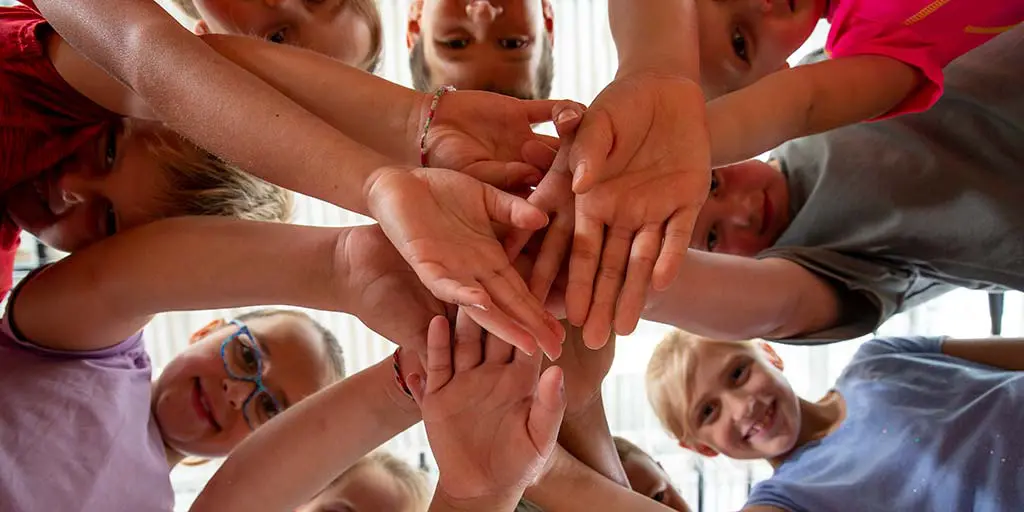
There are many natural ways to incorporate social-emotional learning into Physical Education. Competition, for example, can often lead to high emotions in children. For this reason alone, physical education is an ideal platform to embed SEL by teaching students how to be supportive teammates and respectful competitors.
Y-Charts are an excellent strategy to teach social-emotional and conflict resolution skills. Through the Y-chart approach, students are encouraged to use prior knowledge to construct their own meaning and strengthen their understanding of the concept being taught. Rather than the traditional way of teaching with the teachers doing most of the talking, teachers create a shared learning experience by taking on more of a facilitator role. When teachers talk less and listen more they allow students to take an active role in their learning and motivation increases.
The Y-chart strategy is basically a big Y with sections that include “looks like, sounds like, and feels like”. Teamwork is a good place to start with the Y-chart approach. Divide the class into groups of two or three, begin with small numbers because students may not yet fully understand how to be a good teammate. Each group brainstorms their assigned portion of the chart- either what teamwork looks like, sounds like, or feels like. The class will probably have eight or nine groups, so each portion of the chart will be addressed by more than one group. Give groups three to five minutes to brainstorm ideas. They then report back to the whole group, while the teacher records the responses.
Student-created Y-charts should be placed on the walls around the gym creating a constant visual representation of what teamwork, or whatever concept being learned, looks like, sounds like, and feels like.
Integrate Movement Into Y-charts
While brainstorming a portion of the Y-chart, encourage students to warm-up or cool-down through a walk-n-talk or jog-n-jabber. Then use whole group share-out time for stretching or other stationary activities.
Possible responses may include the following:

Y-charts are also a proactive way to solve problems. Download this sample y-chart document that you can use with your students!
Y-Chart Example: Selecting Partners
For example, the common task of having students pick partners inevitably ends up in conflict or hurt feelings. Allow students to identify those potential problems and then proactively brainstorm solutions.
Consider saying, “Today you are going to work with partners. What are some potential problems when you get to pick your own partners? Students almost always come up with the following reasons:
- “People are only going to choose their friends”
- “People are going to goof around”
- “People are going to be left out”
Now that the potential problems have been identified, let students brainstorm solutions. Consider doing some role-playing. For example, students typically respond, “If someone is left out, include them in your group.” Say: “That’s a great solution, can I have three people come up and show me what that might look like?” Ask questions to deepen understanding. “How does it feel to be left out? How would it feel to be invited into a group?”
Use a Y-chart to strengthen their understanding; “What would picking partners or including others look like, sound like, and feel like if we are going to avoid conflict?”
Y-Chart Example: Listening
A 3rd-grade class was having trouble listening and the teacher dreaded teaching the class. Instead of constantly getting frustrated and blaming the classroom management challenges on the students for being poor listeners, the teacher used a Y-chart for the concept of listening. Each day the class had PE, the teacher asked for reminders of what listening looked like, sounded like, and felt like and then they practiced. Rather than getting upset with kids because they don’t demonstrate positive behaviors, help them learn those desired behaviors through a Y-chart.
Y-charts can be used for almost any social-emotional concept being taught; empathy, compassion, discipline, perseverance, etc.
Proactively teaching social emotional skills by allowing students to construct meaning and brainstorm solutions is a valuable way to minimize conflict. In addition, problem solving through barriers instead of using them as excuses to make poor choices or quit is a great lesson for all ages. Y-charts are an excellent tool to involve students in their learning and set them up for success far beyond their school years.




